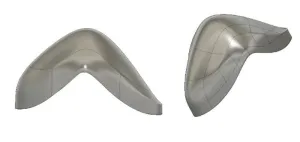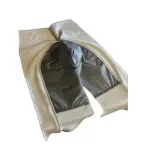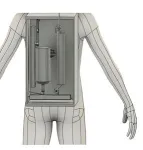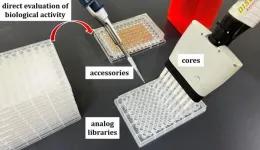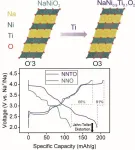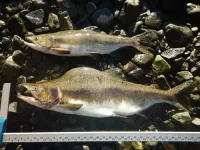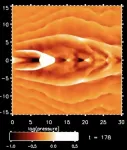(Press-News.org) Astronauts on spacewalks famously have to relieve themselves inside their spacesuits. Not only is this uncomfortable for the wearer and unhygienic, it is also wasteful, as – unlike wastewater on board the International Space Station (ISS) – the water in urine from spacewalks is not recycled.
A solution for these challenges would be full-body ‘stillsuits’ like those in the blockbuster Dune franchise, which absorbed and purified water lost through sweating and urination, and recycled it into drinkable water. Now, this sci-fi is about to become reality, with a prototype novel urine collection and filtration system for spacesuits. The design, by researchers from Cornell University, is published in Frontiers in Space Technology.
“The design includes a vacuum-based external catheter leading to a combined forward-reverse osmosis unit, providing a continuous supply of potable water with multiple safety mechanisms to ensure astronaut wellbeing,” said Sofia Etlin, a research staff member at Weill Cornell Medicine and Cornell University, and the study’s first author.
Designed for upcoming Moon and Mars missions
In 2025 and 2026, NASA is planning for the Artemis II and III missions, where a crew will orbit the Moon and land on its south pole, respectively. These missions are expected to be followed by crewed missions to Mars by the early 2030s. However, astronauts have long complained about a lack of comfort and hygiene of the existing maximum absorbency garment (MAG) – the waste management system of traditional NASA spacesuits –in use since the late 1970s – which functions like a multi-layered adult diaper made of superabsorbent polymer.
“The MAG has reportedly leaked and caused health issues such as urinary tract infections and gastrointestinal distress. Additionally, astronauts currently have only one liter of water available in their in-suit drink bags. This is insufficient for the planned, longer-lasting lunar spacewalks, which can last ten hours, and even up to 24 hours in an emergency,” said Etlin.
Astronauts have also requested that the time needed to fill and de-gas the in-suit drink bags be reduced in future spacesuits, and that a separate supply of non-caffeinated high-energy drink be added.
With all these objectives in mind, Etlin and colleagues have now designed a urine collection device, including an undergarment made of multiple layers of flexible fabric. This connects to a collection cup (with a different shape and size for women and men) of molded silicone, to fit around the genitalia.
The inner face of the collection cup is lined with polyester microfiber or a nylon-spandex blend, to draw urine away from the body and towards the inner cup’s inner face, from where it is sucked by a vacuum pump. A RFID tag, linked to an absorbent hydrogel, reacts to moisture by activating the pump.
High-tech backpack
Once collected, the urine is diverted to the urine filtration system, where it gets recycled with an efficiency of 87% through a two-step, integrated forward and reverse osmosis filtration system. This uses a concentration gradient to remove water from urine, plus a pump to separate water from salt. The purified water is then enriched in electrolytes and pumped into the in-suit drink bag, again available for consumption. Collecting and purifying 500ml of urine takes only five minutes.
The system, which integrates control pumps, sensors, and a liquid-crystal display screen, is powered by a 20.5V battery with a capacity of 40 amp-hours. Its total size is 38 by 23 by 23 cm, with a weight of approximately eight kilograms: sufficiently compact and light to be carried on the back of a spacesuit.
Now that the prototype is available, the new design can be tested under simulated conditions, and subsequently during real spacewalks.
“Our system can be tested in simulated microgravity conditions, as microgravity is the primary space factor we must account for. These tests will ensure the system’s functionality and safety before it is deployed in actual space missions,” concluded Dr Christopher E Mason, a professor at the same institute as Etlin and the study’s lead author.
END
Real-life ‘stillsuit’: Dune-inspired upgrade for spacesuits allow astronauts to recycle urine into water
Where do you go to the bathroom in outer space? Scientists solve the problem with a sci-fi-like recycling suit
2024-07-12
ELSE PRESS RELEASES FROM THIS DATE:
A comprehensive derivative synthesis method for development of new antimicrobial drugs
2024-07-12
A method to screen a wide variety of drug candidates without laborious purification steps could advance the fight against drug-resistant bacteria.
Efforts to combat the increasing threat of drug-resistant bacteria are being assisted by a new approach for streamlining the search for antimicrobial drug candidates, pioneered by researchers at Hokkaido University, led by Assistant Professor Kazuki Yamamoto and Professor Satoshi Ichikawa of the Faculty of Pharmaceutical Sciences. Their methods, developed together with researchers elsewhere in Japan and in the USA, are discussed ...
Improving cycling performance of sodium-ion batteries through titanium substitution
2024-07-12
Researchers at Karlsruhe Institute of Technology (KIT) have made significant advances in sodium-ion battery (SIB) technology by improving cycling performance of the NaNiO2 cathode. They successfully synthesized, for the first time, the cathode active material NaNi0.9Ti0.1O2, which delivers a specific capacity of 190 mAh/g, thus positioning it as a potential candidate for application in high-energy-density SIBs. This innovative approach not only improves battery stability but also propels us toward advanced energy-storage solutions beyond.
With its high theoretical ...
Hatcheries can boost wild salmon numbers but reduce diversity
2024-07-12
The ability of salmon hatcheries to increase wild salmon abundance may come at the cost of reduced diversity among wild salmon, according to a new University of Alaska Fairbanks–led study.
The number of juvenile salmon released into the North Pacific Ocean by hatcheries increased rapidly in the second half of the last century and remains at over 5 billion each year. Salmon hatcheries have helped push annual pink salmon harvests in Prince William Sound from about 4 million fish prior to hatchery programs to roughly 50 million in recent years.
Using data collected from pink salmon streams ...
Artificial intelligence speeds up heart scans, saving doctors’ time, and could lead to better treatment for heart conditions
2024-07-12
Researchers created a computer model that uses AI to examine heart images from magnetic resonance imaging (MRI)
Results were comparable to those worked out by doctors manually, but instead of taking 45 minutes or more, the AI model takes just a few seconds
The AI model could lead to more efficient diagnoses, better treatment decisions and improved outcomes for patients
Researchers have developed a groundbreaking method for analysing heart MRI scans with the help of artificial ...
How the 'heart and lungs' of a galaxy extend its life
2024-07-12
Galaxies avoid an early death because they have a "heart and lungs" which effectively regulate their "breathing" and prevent them growing out of control, a new study suggests.
If they didn't, the Universe would have aged much faster than it has and all we would see today is huge "zombie" galaxies teeming with dead and dying stars.
That’s according to a new study published in the Monthly Notices of the Royal Astronomical Society, which investigates one of the great mysteries of the Universe – why galaxies are not ...
Light-induced Meissner effect in optically driven YBa2Cu3O6.48
2024-07-12
Superconductivity is a fascinating phenomenon, which allows a material to sustain an electrical current without any loss. This collective quantum behavior of matter only appears in certain conductors at temperatures far below ambient.
A number of modern studies have investigated this behavior in so-called non-equilibrium states, that is in situations in which the material is pushed away from thermal equilibrium. In these conditions, it appears that at least some of the features of superconductivity can be recreated even at ambient temperatures. Such non-equilibrium high temperature superconductivity, shown to exist under irradiation ...
Study finds short and long sleep duration associated with blood vessel damage in those recently diagnosed with type 2 diabetes
2024-07-12
New research to be presented at this year’s Annual Meeting of the European Association for the Study of Diabetes (EASD) (Madrid, 9-13 September) shows that people recently diagnosed with diabetes who experience short or long sleep duration are more likely to experience microvascular disease (damage to the small blood vessels), which could ultimately lead to more serious complications. The study is by Mette Johansen and Thomas Olesen, Steno Diabetes Center Odense, Odense University Hospital, Odense, Denmark, and colleagues.
Microvascular complications, such as retinopathy and nephropathy, are major contributors ...
IoT sensors tattle on stores that neglect promo displays
2024-07-11
Whether it’s a pharmacy, a supermarket, or a clothier, when you walk into a retail store in the U.S., you are sure to encounter a flashy promotional display featuring products from a specific brand.
It’s a marketing strategy that’s been proved to be highly effective at boosting sales. Brands carefully plan display campaigns, signing contracts with retailers that specify when to install the exhibits and for how long. They often provide financial incentives to encourage compliance.
But a new study from Ashish ...
A stealth fungus has decimated North American bats but scientists may be a step closer to treating white-nose syndrome
2024-07-11
An invasive fungus that colonizes the skin of hibernating bats with deadly consequences is a stealthy invader that uses multiple strategies to slip into the small mammals' skin cells and quietly manipulate them to aid its own survival. The fungus, which causes the disease white-nose syndrome, has devastated several North American species over the last 18 years.
Scientists have learned much about the fungus, Pseudogymnoascus destructans, since it was first documented in a New York cave in 2006, including where it thrives, its distribution, and clinical features. But exactly ...
Menstrual cramps can be worse in normal-length cycles without ovulation
2024-07-11
According to current understanding, menstrual cramps only happen in cycles in which an egg is released, or an ovulatory cycle. But new research from the University of British Columbia (UBC) is challenging this notion.
The findings, published in the Journal of Pain Research, reveal that some women not only experience cramps when no egg is released, but that cramps can be more severe and last longer during these anovulatory cycles.
“I was surprised to see significant cramps in menstrual cycles with or without ovulation, which challenges current thinking” said co-author, Dr. Paul Yong, associate professor of obstetrics and gynecology at UBC and Canada Research ...
LAST 30 PRESS RELEASES:
Korea University researchers discover that cholesterol-lowering drug can overcome chemotherapy resistance in triple-negative breast cancer
Ushikuvirus: A newly discovered giant virus may offer clues to the origin of life
Boosting the cell’s own cleanup
Movement matters: Light activity led to better survival in diabetes, heart, kidney disease
Method developed to identify best treatment combinations for glioblastoma based on unique cellular targets
Self-guided behavioral app helps children with epilepsy sleep earlier
Higher consumption of food preservatives is associated with an increased risk of type 2 diabetes
NTU Singapore-led team captures first-ever ‘twitch’ of the eye’s night-vision cells as they detect light, paving the way for earlier detection of blindness-causing diseases
Global aviation emissions could be halved through maximising efficiency gains, new study shows
Fewer layovers, better-connected airports, more firm growth
Exposure to natural light improves metabolic health
As we age, immune cells protect the spinal cord
New expert guidance urges caution before surgery for patients with treatment-resistant constipation
Solar hydrogen can now be produced efficiently without the scarce metal platinum
Sleeping in on weekends may help boost teens’ mental health
Study: Teens use cellphones for an hour a day at school
After more than two years of war, Palestinian children are hungry, denied education and “like the living dead”
The untold story of life with Prader-Willi syndrome - according to the siblings who live it
How the parasite that ‘gave up sex’ found more hosts – and why its victory won’t last
When is it time to jump? The boiling frog problem of AI use in physics education
Twitter data reveals partisan divide in understanding why pollen season's getting worse
AI is quick but risky for updating old software
Revolutionizing biosecurity: new multi-omics framework to transform invasive species management
From ancient herb to modern medicine: new review unveils the multi-targeted healing potential of Borago officinalis
Building a global scientific community: Biological Diversity Journal announces dual recruitment of Editorial Board and Youth Editorial Board members
Microbes that break down antibiotics help protect ecosystems under drug pollution
Smart biochar that remembers pollutants offers a new way to clean water and recycle biomass
Rice genes matter more than domestication in shaping plant microbiomes
Ticking time bomb: Some farmers report as many as 70 tick encounters over a 6-month period
Turning garden and crop waste into plastics
[Press-News.org] Real-life ‘stillsuit’: Dune-inspired upgrade for spacesuits allow astronauts to recycle urine into waterWhere do you go to the bathroom in outer space? Scientists solve the problem with a sci-fi-like recycling suit
